
The Bureau of Labor Statistics predicts above-average growth in the veterinary field through 2028. While this is great news for our four-legged friends, it also means a rise in competition amidst veterinary practices.
To build awareness of your practice and grow your patient base, it’s vital to implement a proactive marketing strategy.
If you want a larger piece of the $19 billion veterinary care market, you’ll need to keep your practice at the forefront of people’s minds and position yourself as an authority in pet care in your local community.
A well crafted veterinary blog allows you to do both while improving your digital presence. Explore some effective veterinary blog topics that can elevate your practice to best in show.
- Why is blogging important for veterinarians
- Veterinary blog topics that pet parents want to read
- Brainstorming tip: Finding veterinary blog topics using Google Trends
- Brainstorming tip: Find blog topics using Google Suggest, and People Also Ask
- Best practices for using veterinary blogs as a marketing tool
- Get your website out of the doghouse with a best in show blog
Why is blogging important for veterinarians
Search engine optimization (SEO) refers to steps a business can take to rise in digital prominence. Higher rankings in search results mean more eyes on your practice and more appointments scheduled. Blogging is an integral part of this strategy.
Let’s see this in action.
Picture Izabella, a 25-year-old with a young Boston Terrier. She noticed that her dog, Pogo, often has irritated eyes. So she heads to the internet for answers. She types in “why does my Boston Terrier have eye problems?” At the very top of the results page is a snippet of useful information.

As you can see, this information comes from the Prestige Animal Hospital website. Izabella did not enter the search explicitly looking for a veterinary clinic. But she ends up on the website of a local veterinary practice and gains helpful facts from it. Now the practice is top of mind for her, and if the eye problems persist, she’s likely to take Pogo here.
This is search engine optimization at work. Prestige Animal Hospital took the time to create a pet health blog with valuable content. Search engines recognized this and pulled the piece onto the results page. The increased visibility of your practice is a prime SEO benefit of blogging.
Blogging also allows you to build trust. A sweeping 95% of pet owners view their pets as family members. As such, they want what is best for their beloved pets. Positioning your practice as an authority on topics surrounding animal health will help lift you not just in search rankings but in the eyes of readers.
Veterinary blog topics that pet parents want to read
An untrained pet can cost an owner in damages and time. An unfocused blog can have a similarly draining effect.
Skip the beginner blogging woes and focus on the intersection of what people are searching for and your area of expertise.
Below are a handful of veterinary blog topics that fit in this zone.
1. Cost focused posts
Often practices shy away from discussing costs on their website for fear of scaring off customers. But the fact is, customers appreciate price transparency. Furthermore, people are willing to spend a great deal on their pets. One survey of pet owners found that 45% of them spent an equal or greater amount on pet healthcare than on their own.
When we search for average prices of veterinary visits, the results page does not have a single post by a veterinary clinic.
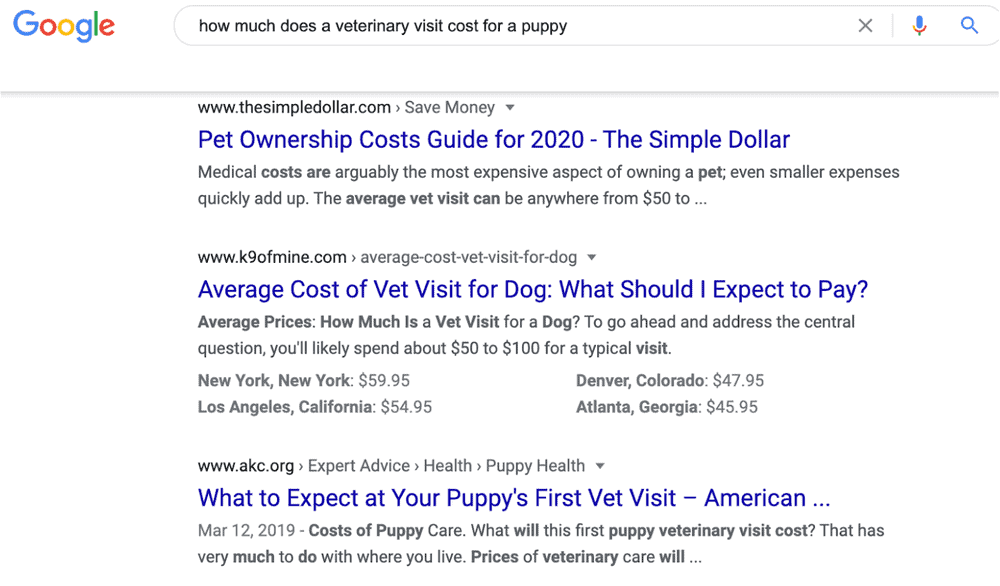
This is a great opportunity for an authoritative source (aka your practice) to provide accurate information on the topic. If providing exact prices is not feasible, offer ranges and details about what can influence costs instead. This is still useful information that pet owners would like to know.
2. Instructive pet ownership guides
Both seasoned pet owners and newbies alike face challenges in keeping pets happy and healthy. As a professional in animal health, you are in a prime position to produce guides about navigating these topics.
Your practice can produce guides on how to:
- Select the right breed of dog for your lifestyle
- Keep your pet’s dental health in good shape
- Protect your pet from fleas and ticks
- Ensure essential vitamins and nutrients are in your pet’s diet
This veterinary blog topic is versatile and leaves room for creativity. If the guides gain traction, consider making them gated content. This means that people will have to input some type of contact information (typically an email) to access the guide.
3. Myth buster posts
Thanks to Reddit forums, Youtube, and a host of other easily accessible platforms, there is a lot of information swirling around online about pets and how to take care of them. Unfortunately, it is not always accurate.
Dispel misinformation and assert your expertise in one fell swoop with a myth-busting blog post. These are fun and informative posts that can generate shares on social media and educate ill-informed owners.
Ethos Veterinary Hospital addressed common misconceptions and corrected them with real facts on its pet health blog.
4. Locally centered posts
According to Google, 76% of people who search for something nearby on their smartphones end up visiting the business within the next 24 hours.
Your practice serves people in a specific area, so it only makes sense to target these individuals with your blog. Make it clear to search engines and readers that you are addressing people in a certain location. You don’t need to do this in all of your posts. But having specific pieces of content that focus on locals is a great boost for your site.
Be sure to weave the city name into titles of blog posts and throughout articles. Think: 5 Summer Safety Measures Phoenix Dog Owners Must Take or How to Choose a Veterinarian in Phoenix.
5. Question & answer posts
You receive questions from concerned and curious pet owners each day. People are likely to ask similar questions online. So why not turn some of these inquiries into content for your pet health blog? Dr. Marty Becker, aka “America’s Veterinarian,” frequently writes Q&A style posts on his successful blog.

Since questions are continually rolling in, you’ll have a great source of potential topics at the ready.
Brainstorming tip: Finding veterinary blog topics using Google Trends
For a look at what people are searching for online, head to Google Trends. There are a few things to know about this tool.
First off, it is free to use. Secondly, it is a great way to gauge public interest in a topic and understand if it’s worth writing about.
Here’s how it works.
First things first, we need to search a term to analyze the trends. Since Google Trends works well with broad, short-tail keywords, we’ll type “dog vaccines.” We set the time frame to show data over the past 12 months because this longer period shows a complete picture of interest in the term.
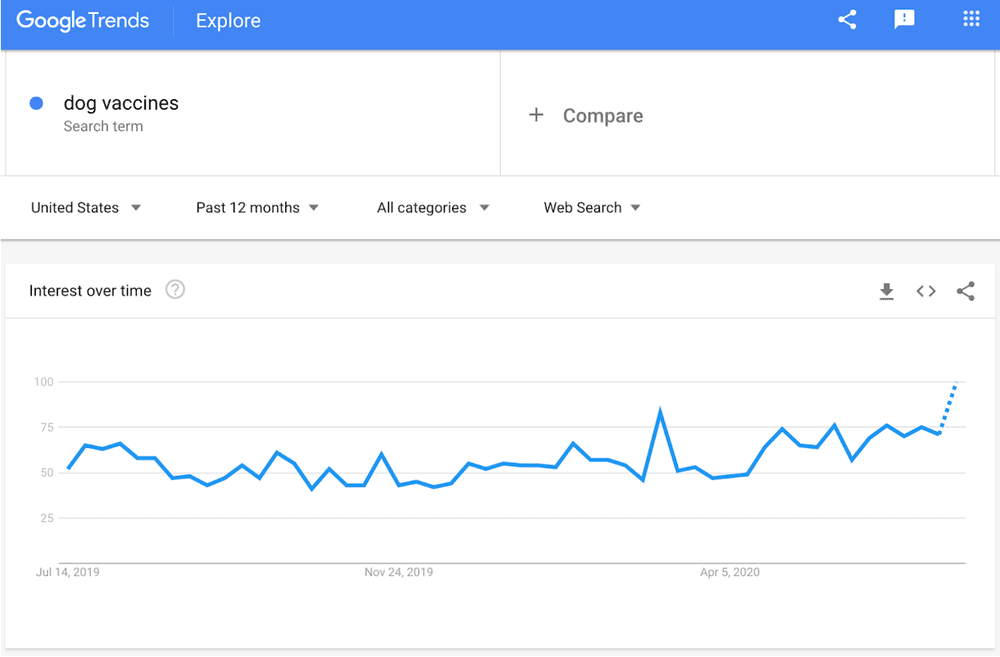
The graph reveals a relatively steady level of interest and appears to be increasing in popularity. This is a sign that this topic may be worthwhile to write about if we can nail down a more specific angle to address it from.
Narrow this down with a trip to the ‘Related Queries’ section
The keyword “dog vaccines” offers a topic to write about, but it is not specific enough to begin writing on. It is broad, and ranking for this keyword would be difficult. That’s why the next step involves finding a more specific query to address.
Scroll down below the graph to the box labeled ‘Related Queries.’
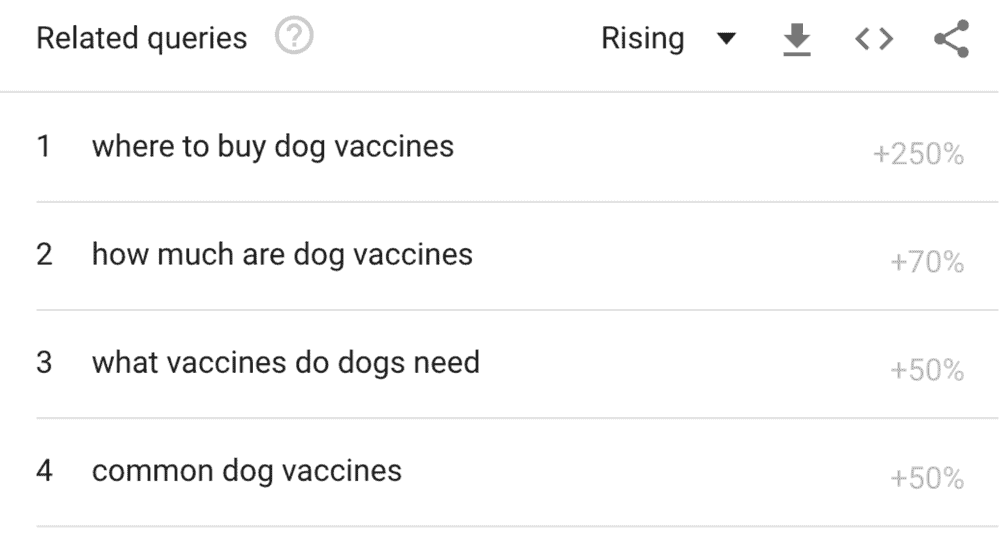
Now we can see search terms with a bit more specificity to them. The numbers to the right indicate the percentage increase in interest that each term is experiencing. From here, you can select what topic to address and even narrow it down more.
Brainstorming tip: Find blog topics using Google Suggest, and People Also Ask
It takes a bit of time to sift through topics and find viable options in Google Trends. If you’re looking for a lot of ideas in a short time frame, turn to Google Suggest, and People Also Ask.
Don’t finish that thought.
Open a new window on your laptop or tab in your smartphone and head over to Google. In the search bar, begin typing a question or topic that you’d like to cover in a blog post. You don’t have to have a full idea here. Part of a thought is good enough.
Rather than pressing enter, let Google Suggest provide a list of potential topics. For instance, when we search, “why is my cat,” a litany of potential blog topics appear.
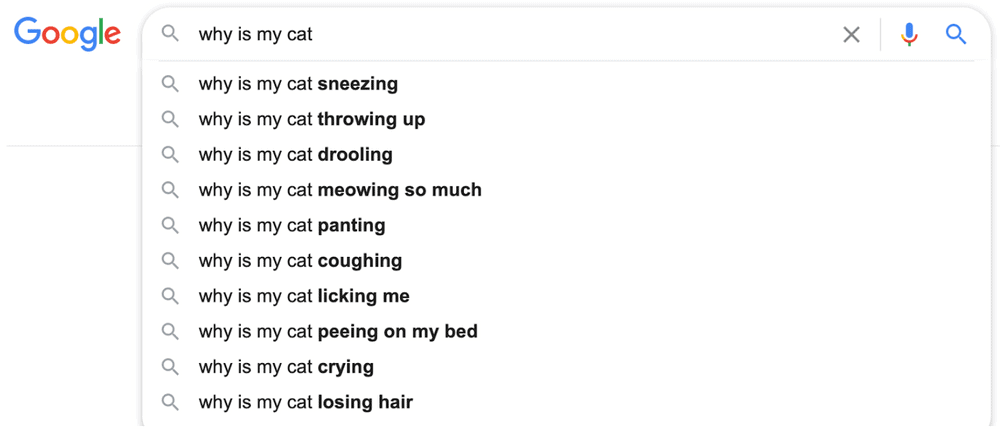
Rinse and repeat with different beginning phrases until you find a popular query to write about.
Take advantage of ‘People also ask’
Another great source of veterinary blog topics comes from the search results page itself. To activate it, simply search a term you may write about. We’ll use one from above—”why is my cat coughing.” This time, we will press enter. Near the top of the page is a box labeled ‘People also ask.’
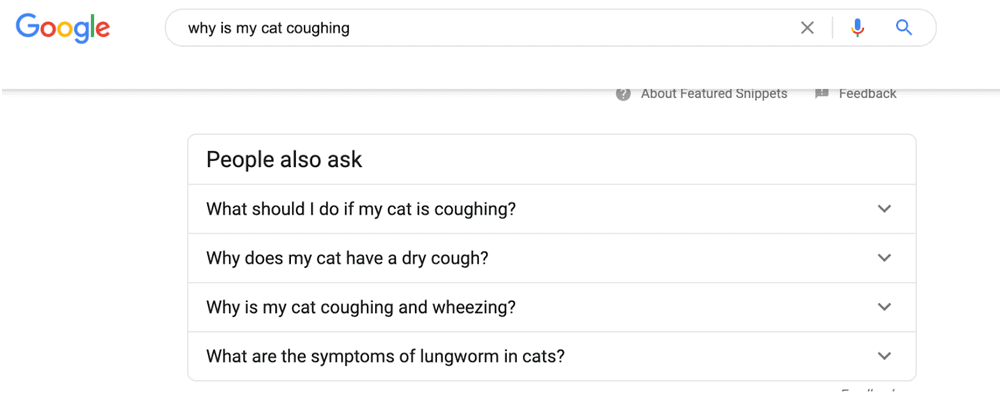
These questions all relate to the search term, but they take it in different directions. These could be used as headings in a blog post about cats coughing, or you could use one of these questions as the main topic of a post.
Best practices for using veterinary blogs as a marketing tool
With multiple ways to unearth topics for your veterinary blog, you’re on track for content success. The next step is to implement specific practices that ensure your blog runs smoothly and is worth the resources you invest in it.
- Align blog goals with practice goals. Are you looking to maintain your current roster of clients? Is the main goal to grow and expand to a new location? Is there a certain service offering that you would like more customers to bring their pets in for? Whatever the goals of your practice are, use your blog to help achieve them. It’s better to know your goal from the start so that all pieces of content are working in unison, and so that time and resources are not being used for an unclear purpose.
- Pay attention to URLs. The web address in the bar at the top of each page is known as the URL. You may not notice them much, but search engines examine URLs to understand what the page is addressing. Make sure to optimize your URLs to help your website reach a higher standing on the results page. This means keeping them short and easy to read.
- Quality is king. Blogging consistently is key for SEO. So what’s the harm in creating a less than amazing piece every once in a while? It can be quite substantial. That’s why 23.84% of readers say that bad content destroys a blog’s credibility. Plus, a low-quality piece is destined to be invisible in the search results. Make sure that your content adequately addresses the topic at hand and that it is targeting a keyword throughout the piece. You can also improve the content that is lacking by adding more information and updating it with current facts.
- Address technical problems on your website. Slow loading times can deter users from staying on your website. 40% of people leave a site that has a loading time over three seconds. Luckily, Google Search Console is a free tool that brings technical problems like slow site speed to your attention. It also proposes solutions to tackling these issues.
Get your website out of the doghouse with a best in show blog
To maximize the effectiveness of your blog, it’s important to continually produce fresh content and improve the technical aspects of your website. The rewards of increased visibility and new customers make the blogging journey well worth it. But the initial time spent can spread your team too thin. And beginner mistakes can prevent you from reaching higher in the rankings.
Sidestep the headache and partner with a skilled team of content marketing professionals. The SEO specialists at Markitors know what it takes to get your business noticed by the right people. Our local SEO, content writing, and digital PR services have combined to help hundreds of clients reach their goals. Plus, Marktiors has a special love for animals, as you can see from our Instagram snaps featuring our barketing team.

If you want a comprehensive marketing plan that brings results to your practice, don’t hesitate to reach out to us. We look forward to connecting your business to more customers.









